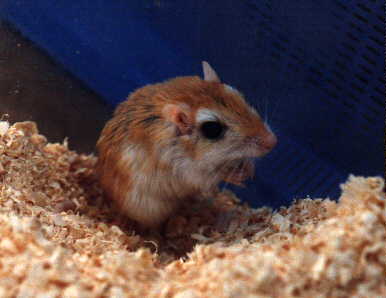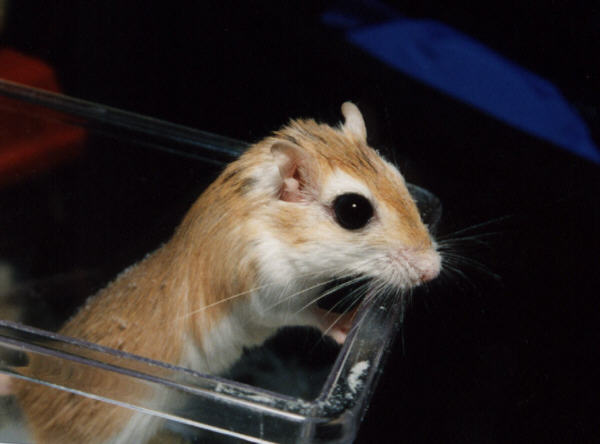The Pallid gerbil (Gerbillus Perpallidus) lives in the arid
areas of North Africa and is sometimes confused with the Egyptian
Gerbil (Gerbillus Gerbillus) which is a different, although
very similar species.
In appearance this gerbil is quite different to the Mongolian Gerbil usually
seen in pet shops. Firstly it is smaller. Males are about three-quarters the
size of an adult Mongolian Gerbil whilst the female is significantly smaller
still. The colouring is both lighter and brighter than that of the agouti
coloured Mongolian Gerbil. The overall effect is much more orange than brown,
and the belly is brilliant white. The body and limbs are much more finely boned
than the Mongolian Gerbil and the tail is much longer, only sparsely haired and
with no tuft. Eyes are much larger in proportion to the head that is much more
pointed in shape. The ears are larger and stand more erect.

Pallids make good pets. In general their habits and temperament are like
those of the Mongolian Gerbil. They are social animals who seem to get bored and
depressed when kept alone. They will live quite happily in single sex groups but
large groups containing both sexes are sometimes unstable with occasional
outbreaks of violence. In most respects they can be kept in the same manner as
Mongolian Gerbils.
![[Picture]](images/thumb24.jpg)
![[Picture]](images/thumb26.jpg)
![[Picture]](images/thumb27.jpg)
Pallids are very keen on burrowing and should therefore be kept
in a tank instead of a cage. They like climbing so items suspended from the lid
of the tank is a good idea.
![[Picture]](images/thumb25.jpg)
![[Picture]](images/thumb38.jpg)
![[Picture]](images/thumb40.jpg)
They eat the same mix of seeds etc. They are more likely than Mongolian
Gerbils to eat insects such as mealworms if offered and are less likely to eat
fruit and vegetables.
Pallid gerbils pair up in the same way as Mongolian Gerbils. All the advice
in the Gerbil FAQ on breeding and sexing is valid for
Pallids. The only differences are that Pallids seem to gestate for a slightly
shorter period and that they take slightly longer to become sexually mature.
![[Picture]](images/thumb39.jpg)
![[Picture]](images/thumb37.jpg)

I am grateful to
who has sent me the following information.
PALLID GERBIL (Gerbillus perpallidus)
DISTRIBUTION IN EGYPT - Western Desert between the western
part of Nile Delta, Qattara Depression, and Western Mediterranean Coastal Desert
environs El Hamman.
DIAGNOSIS - Medium size gerbil with pale orangish upper
parts lacking dorsal stripe. Tail brush relatively inconspicuous, fuscous. Ears
not pigmented. Skull not strongly developed, supraorbital ridges not heavy.
Nasal tapering and narrow, "bottle shaped" posteriorly. Interparietal
shallow and broad. Bulla extending posteriorly beyond paroccipital. Adult head
and body length average 107 mm.; tail 137 mm., 129 per cent of head and body
length; hind foot 34 mm.; ear 16 mm.; occipitonasal length 32.3 mm.; weight 36.3
g. Dorsal colour pale yellowish orange to light reddish orange with no dorsal
stripe, but dark-tipped hairs on rump. Hairs of dorsum and part of side have
gray bases. Underparts, feet, and under side of tail white. Mystacial and
suborbital areas without pigmented hairs. Postorbital and postauricular spots
and rump patch white, conspicuous. Dorsal tail colour as back, Lacking brownish
tipped hairs; brush about one-third of tail length, fuscous. Glans penis and
baculum not observed.
VARIATION - Colour varies from pale yellowish orange in the
wadi el Natroun area to light reddish orange in El Maghra.
HABITATS - Idku: Coastal sand dunes. Western Mediterranean
Coastal Desert: Coastal dunes of white, nummilitic sand; sandy areas in stands
of Thymelaea hirsuta and Artemisia monosperma in the southern limits of
vegetation. Wadi el Natroun: Lake shore areas of mud and salty sand supporting
Typha sp. and Desmostachya bipinnata; almost barren sand slopes with dry,
ephemeral Mesembryanthemum sp.; soft sand sheets supporting stands of Pnicum
turgidum; dunes under exotic Prosopis juliflora; sandy slopes near clover
fields, but not within the fields. Bir Victoria: Sand sheets and meanders with
dominats of Artemisia monosperma, Panicum turgidum, and Pityranthus tortuosa. El
Magra: Sand mounds around Nitraria retusa and Zygophyllum album, barren sand and
gravel slopes, and 15 km. W in soft sand in scattered Acasia raddiana.
REPRODUCTION - One record of five fetuses in April.
FOOD - ??
REFERENCE: Osborn, D, J., and I. Helmy. 1980. The
contemporary land mammals of Egypt (including Sinai). Fieldiana Zool., no. 5.




























Return to the NGS Homepage?
The views presented on this page are not necessarily those of the National
Gerbil Society.
Please note that the material on these webpages is covered by copyright law.
If you wish to use any pictures etc for anything other than your personal
private use, such as publishing material on a website, then
This web page may include links to other web sites. These links are provided
in order to enhance the interest and usefulness of other content and are not
intended to signify that the National Gerbil Society, or the authors of material
featured on the NGS Website, endorses or otherwise has any responsibility for
the content of any linked web page, web site or other linked material.
This page has been constructed by
Telephone number for media contact only - (+44)
07941893143
Last updated 22 November 2013



![[Picture]](images/thumb24.jpg)
![[Picture]](images/thumb26.jpg)
![[Picture]](images/thumb27.jpg)
![[Picture]](images/thumb25.jpg)
![[Picture]](images/thumb38.jpg)
![[Picture]](images/thumb40.jpg)
![[Picture]](images/thumb39.jpg)
![[Picture]](images/thumb37.jpg)